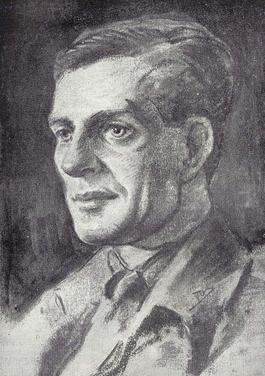
Lieutenant Colonel Airey Middleton Sheffield Neave, was a British soldier, lawyer and Member of Parliament (MP) from 1953 until his assassination in 1979.
Lieutenant Albert Michael Sinclair, DSO, known as the Red Fox, was a British prisoner at Colditz Castle during World War II. He was involved in a number of escape attempts and was recognised within the camp for his determination to escape. Sinclair was the only person to be killed while attempting to escape Colditz.
Patrick Robert Reid, was a British Army officer and author of history. As a British prisoner of war during the Second World War, he was held captive at Colditz Castle when it was designated Oflag IV-C. Reid was one of the few to escape from Colditz, crossing the border into neutral Switzerland in late 1942.

Howard Douglas Wardle MC, commonly known as Hank, was a Canadian pilot in the Royal Air Force during World War II. He is notable for being one of the only two men who escaped from both Spangenberg and Colditz prison camps during World War II.

Oflag IV-C, generally known as Colditz Castle, was a prominent German Army prisoner-of-war camp for captured Allied officers during World War II. Located in Colditz, Saxony, the camp operated within the medieval Colditz Castle, which overlooks the town. The word "Oflag" is an abbreviation of the German term Offizierslager, meaning "officers' camp." The camp held officers who were deemed escape risks or who had already attempted escape from other prison camps. Known for its seemingly impenetrable structure, Colditz Castle became a site of numerous escape attempts, some of which were successful, earning a reputation for the ingenuity and daring of its prisoners. The camp's history and the elaborate escape plans conceived there have been widely covered in postwar memoirs, books, and media. Today, Colditz Castle has become a popular tourist destination, with guided tours, exhibitions and a museum dedicated to the prisoners' life.

Oflag VII-C was a World War II German prisoner-of-war camp for officers located in Laufen Castle, in Laufen in south-eastern Bavaria from 1940 to 1942. Most of the prisoners were British officers captured during the Battle of France in 1940. To relieve overcrowding, some of the officers were transferred to Oflag VII-C/Z in Tittmoning Castle. The Oflag existed only for a short time. In early 1942 all the officers were transferred to Oflag VII-B in Eichstätt.
Brigadier Robert George William Melsome MBE was a senior British Army officer and English cricketer. He saw active service during the Second World War, but spent much of the war as a prisoner of war in Germany.
Brigadier Hugo Craster Wakeford Ironside OBE was a British Army officer who, during World War II, tunnelled out of a Prisoner of War camp and later helped construct a glider, known as the 'Colditz Cock'.
John Robert Edward Hamilton-Baillie MC, was a British Royal Engineers officer famed for numerous escapes from German prisoner of war camps during World War II. During his later life he was a founder of the Fortress Study Group, a prominent member of the Concrete Society, and a dedicated fund raiser for the Red Cross.

Hedley Nevile 'Bill' Fowler was a British Royal Air Force pilot who became a prisoner of war and successfully escaped from Oflag IV-C at Colditz during the Second World War.
Lieutenant Colonel Ronald Bolton Littledale DSO was a British Army officer who became a prisoner of war and successfully escaped from Colditz Castle during the Second World War but was killed in action on 1 September 1944.
Hugh Glenrinnes Bruce was a prisoner of war in Colditz Castle and later commanding officer of the Special Boat Service.
Henry Gwyn Davies-Scourfield, born Henry Gwyn Saunders Davies, was a Welsh horse racing jockey and first-class cricketer.
Brigadier-General Frank Henry Burnell-Nugent,, born Frank Henry Nugent, was an English first-class cricketer and British Army officer. Burnell-Nugent had a distinguished career in the army, serving with the Rifle Brigade between 1899 and 1933 and seeing action in the Second Boer War and the First World War. As a cricketer, he made one appearance in first-class cricket for Hampshire.

Stalag XXI-D was a German World War II prisoner-of-war camp based in Poznań in German-occupied Poland, operated in 1940–1945. It held Polish, French, British, Belgian, Dutch, Serbian, Soviet and Italian POWs.
Lieutenant Colonel David Peter Lafayette Hunter MC was a Royal Marines officer who was prisoner of war captive in Colditz Castle during the Second World War. He later served as the commanding officer of 40 Commando, and was a recipient of the Military Cross.

John Francis Arundell, 16th Baron Arundell of Wardour JP TD was a British soldier and member of the House of Lords.
General Sir Reginald Byng Stephens, was a British Army general of the First World War and later Commandant of the Royal Military College, Sandhurst, from 1919 to 1923, Major-General commanding the 4th Division, 1923 to 1926, and Director-General of the Territorial Army, 1927 to 1931.

Captain Richard Herbert Howe was a British army officer during World War II. He was captured by the Germans in 1940 and eventually held in Oflag IV-C, at Colditz Castle, where he served as Escape Officer from 1942 to 1945. He organised many escapes including eight successful home runs of British officers.

Brigadier Robert George Long, was a British Army officer who was the last Colonel of the Royal Hampshire Regiment.









